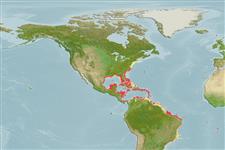Environment: milieu / climate zone / depth range / distribution range
Ecología
marino asociado a arrecife; rango de profundidad 2 - 50 m (Ref. 7345), usually 2 - 18 m (Ref. 27115). Tropical; 43°N - 27°S, 100°W - 4°W (Ref. 55165)
Western Atlantic: New York, USA and Bermuda to the Gulf of Mexico and Brazil. Eastern Atlantic: Ascension Island (Ref. 7345).
Length at first maturity / Tamaño / Peso / Age
Maturity: Lm ?, range 13 - ? cm
Max length : 39.0 cm TL macho / no sexado; (Ref. 36453); common length : 25.0 cm TL macho / no sexado; (Ref. 5217)
Espinas dorsales (total): 9; Radios blandos dorsales (total): 26-28; Espinas anales 3; Radios blandos anales: 24 - 26. A deep-bodied surgeonfish (body depth 1.7 in SL) with a conspicuous yellow caudal spine. Has the most distinctive coloration of all western Atlantic surgeonfishes (Ref. 26938).
Inhabits coral reefs, inshore grassy or rocky areas. Forms small groups (Ref. 26235). Mainly diurnal. Feeds entirely on algae (Ref. 5521). At Fernando de Noronha Archipelago in southwestern Atlantic, juveniles hold cleaning stations together with the doctorfish (Acanthurus chirurgus) and sergeant major (Abudefduf saxatilis) and graze algae as well as pick molted skin and parasites from green turtles (Chelonia mydas). This behavior is preceded by a characteristic inspection usually followed by feeding nips on the turtles’ skin (head, limbs, and tail), as well as on the carapace. The most inspected and cleaned body parts are the flippers (Ref. 51385). Diurnal species (Ref. 3194). It forms resident spawning aggregations in late afternoon after high tide (Ref. 27825, 120681, 120682). The spine on both sides of the caudal peduncle may inflict painful wounds (Ref. 5217). Marketed fresh. Maximum depth reported taken from Ref. 127989.
Life cycle and mating behavior
Madurez | Reproducción | Puesta | Huevos | Fecundidad | Larva
Robins, C.R. and G.C. Ray, 1986. A field guide to Atlantic coast fishes of North America. Houghton Mifflin Company, Boston, U.S.A. 354 p. (Ref. 7251)
IUCN Red List Status (Ref. 130435)
Threat to humans
Traumatogenic (Ref. 4690)
Human uses
Warning: mysqli::__construct(): (HY000/1040): Too many connections in /var/www/html/includes/func_getlabel.php on line 46
Can't connect to MySQL database (fbapp). Errorcode: Too many connections
